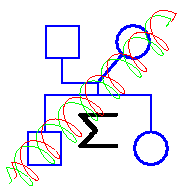
1. Scientists are trying to map a rare autosomal recessive trait, in a population in which the trait allele frequency is 0.01. The trait does not impact survival or fertility of individuals. In the population, 5% of marriages are between first cousins (g = 1/16) and 20% of marriages are between second cousins (g = 1/64). The remainder are between unrelated individuals.
(a) What is the mean inbreeding coefficient in the population? What is the frequency of affected individuals?
(b) Scientists collect their individuals through a registry of
affected individuals maintained by a Support Association (SA). Assuming each
affected individual has the same probability of being registered with
SA, independently of his/her relatives, what
proportion of the individuals of SA's list are the offspring of
first cousins, and of second cousins?
(Ans: 0.222 and 0.314)
(c) What is the probability that an affected
offspring of a first cousin marriage
is ibd at the trait locus? And for the offspring of a second-cousin
marriage?
(Ans: 0.869 and 0.613)
2. Continuing from Qu.1, through SA the scientist enroll 40 unrelated
affected individuals:
20 of them are the offspring of
first-cousin marriages and 20 are the offspring of a
second-cousin marriages. By good luck, they
have a marker so tightly
linked to the trait locus that the recombination frequency r is essentially
0.
At this marker there are four alleles, each having frequency
0.25.
(a) What is the probability that an affected offspring of a first-cousin
marriage is homozygous at the marker locus? And for the offspring of a
second-cousin marriage?
(Ans: 0.902 and 0.710).
(b) What is the probability that all 40 affected individuals are homozygous at this marker locus?
(c) Assuming r=0, show that for the offspring of first cousins, each one homozygous at the marker contributes 0.48 to the base-10 lod score, and each one that is heterozygous contributes -0.86. For the offspring of second cousins, show that each one that is homozygous at the marker contributes 0.43, and each one that is heterozygous contributes -0.41. Hence find the overall Elod (expected lod score) from this sample.
3.
In this
question, we assume
Haldane's model of no interference. You may assume the corresponding
Haldane map function relating genetic distance to recombination rate.
(a) Show that the recombination frequency between two loci
is an increasing function
of genetic distance, and that when the loci are tightly linked, the
recombination probability is approximately the genetic distance
(in Morgans).
(b) (Lange, Chapter 7: number 1)
Suppose loci are ordered, 1,2,3,...,L along a chromosome, and rj
is the recombination frequency between locus j and locus j+1.
Show that
the recombination frequency r
between locus 1 and locus L satisfies the formula (according to Lange, due
to Trow)
(1- 2 r) is the product of the (1- 2 rj)
(Lange suggests using induction, but I think it's much easier to convert
to genetic distance.)
4. (Mather's formula, Mather (1938))
Note each chiasma in
meiosis involves two of the four chromatids, and hence has probability
1/2 of being in a resulting gamete. We say there is no
chromatid interference if each chiasma has probability
1/2 of being in a resulting gamete, INDEPENDENTLY of the others.
(a) If a fair coin is tossed 1,2 or 3 times, what is the probability of an
odd number of heads?
(b) Show by induction (or elsehow if you prefer), that if a fair coin
is tossed any number of N of times (N>0), the probability of an odd
number of heads is 1/2.
(c) Deduce Mather's formula, that the recombination probability is
(1/2) P(N>0), where N is the random
number of chiasmata between the two loci in a meiosis.
(d) Show that this means that, in a very small segment of chromosome
where P(N > 1) is negligible, the recombination probability is approximately
the genetic distance (in Morgans).